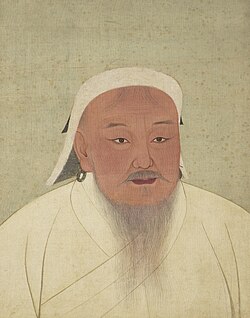| Millennium |
|---|
| 2nd millennium |
| Centuries |
| Timelines |
| State leaders |
| Decades |
| Categories: |
|
Births – Deaths Establishments – Disestablishments |

The 13th century was the century which lasted from January 1, 1201 (represented by the Roman numerals MCCI) through December 31, 1300 (MCCC) in accordance with the Julian calendar.
The Mongol Empire was founded by Genghis Khan, which stretched from Eastern Asia to Eastern Europe. The conquests of Hulagu Khan and other Mongol invasions changed the course of the Muslim world, most notably the Siege of Baghdad (1258) and the destruction of the House of Wisdom. Other Muslim powers such as the Mali Empire and Delhi Sultanate conquered large parts of West Africa and the Indian subcontinent, while Buddhism witnessed a decline through the conquest led by Bakhtiyar Khilji. The earliest Islamic states in Southeast Asia formed during this century, most notably Samudera Pasai.[1] The Kingdoms of Sukhothai and Hanthawaddy would emerge and go on to dominate their surrounding territories.[2]
Europe entered the apex of the High Middle Ages, characterized by rapid legal, cultural, and religious evolution as well as economic dynamism. Crusades after the fourth, while mostly unsuccessful in rechristianizing the Holy Land, inspired the desire to expel Muslim presence from Europe that drove the Reconquista and solidified a sense of Christendom. To the north, the Teutonic Order Christianized and gained dominance of Prussia, Estonia, and Livonia. Inspired by new translations into Latin of classical works preserved in the Islamic World for over a thousand years, Thomas Aquinas developed Scholasticism, which dominated the curricula of the new universities.[3] In England, King John signed the Magna Carta, beginning the tradition of Parliamentary advisement in England. This helped develop the principle of equality under law in European judisprudence.[4]
The Southern Song dynasty began the century as a prosperous kingdom but were later invaded and annexed into the Yuan dynasty of the Mongols. The Kamakura Shogunate of Japan successfully resisted two Mongol invasion attempts in 1274 and 1281. The Korean state of Goryeo resisted a Mongol invasion, but eventually sued for peace and became a client state of the Yuan dynasty.[5]
In North America, according to some population estimates, the population of Cahokia grew to be comparable to the population of 13th-century London.[6] In Peru, the Kingdom of Cuzco began as part of the Late Intermediate Period. In Mayan civilization, the 13th century marked the beginning of the Late Postclassic period. The Kanem Empire in what is now Chad reached its apex. The Solomonic dynasty in Ethiopia and the Zimbabwe Kingdom were founded.
- ^ "Samudra Pasai worthy to be world historical site". Republika Online. 2017-03-24. Retrieved 2020-01-24.
- ^ Coedès, George (1968). Walter F. Vella (ed.). The Indianized States of Southeast Asia. trans.Susan Brown Cowing. University of Hawaii Press. ISBN 978-0-8248-0368-1.
- ^ "St. Thomas Aquinas". Catholic Encyclopedia. Retrieved 2023-12-09.
- ^ Brooks, Christopher (2020). Western Civilization: A Concise History. NSCC Libraries Pressbooks.
- ^ Lee, Kenneth B. (1997). Korea and East Asia: The Story of a Phoenix. Greenwood Publishing Group. ISBN 9780275958237.
- ^ "Greater London, Inner London Population & Density History". www.demographia.com. Retrieved 2023-02-10. Quoting from The London Encyclopedia, Ben Weinreb and Christopher Hibbert, ed., Macmillan, 2010, ISBN 1405049251